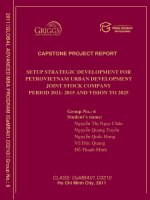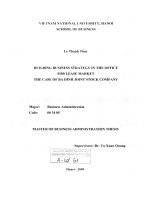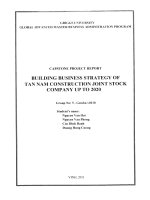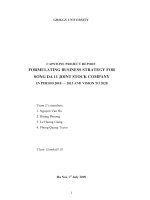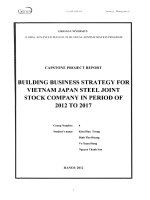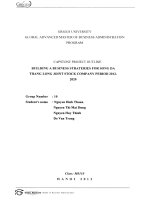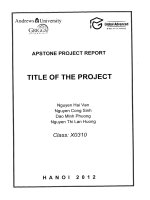Business strategy development of manganese mineral joint stock company period 2011 - 2020
Bạn đang xem bản rút gọn của tài liệu. Xem và tải ngay bản đầy đủ của tài liệu tại đây (795.89 KB, 55 trang )
CAPSTONE REPORT
BUSINESS STRATEGY DEVELOPMENT OF
MANGANESE MINERAL JOINT STOCK COMPANY
PERIOD 2011 - 2020
Group: 9
Members:
1. Phan Nguyễn Quốc Khánh
2. Bùi Văn Minh
3. Võ Văn Hải
4. Hoàng Quốc Trường
NGHE AN, 2011
Griggs University
Global Advanced Master of Business Administration
Capstone project peport - Group: 9 - Class: GAMBA 01.V03
Business Strategy Development of Manganes Mineral Joint Stock Company –
Period 2011 – 2020
- 1/ 53 -
ACKNOWLEDGEMENTS
In the process of completing this capstone project, we would like to express our
sincere thank to our lectures of Global Advanced Master of Business Administration –
ETC – VNU and Griggs University for not only the valuable knowledge but also the
mental support they have provided us during the past period.
We would like to express our gratitude to the Management Board and other
executives of Manganese Mineral Joint Stock Company and its parent company – Ha
Tinh Mineral and Trading Corporation for supporting us as well as providing us with
useful comments during the process of completing this project.
Due to the limitations of time and our knowledge, it is inevitable that our report
- “Business Strategy Formulation of Manganese Joint Stock Company for 2011 –
2020” may have some limitations. We hope to continuously receive support and advice
from our lectures of Global Advanced Master of Business Administration –ETC –
VNU and Griggs University as well as the Management Board and other executives of
Ha Tinh Mineral and Trading Corporation ; Manganese Mineral Joint Stock Company;
sothat we can improve our captone report.
Best Regards and Many Thanks!
Griggs University
Global Advanced Master of Business Administration
Capstone project peport - Group: 9 - Class: GAMBA 01.V03
Business Strategy Development of Manganes Mineral Joint Stock Company –
Period 2011 – 2020
- 2/ 53 -
TABLE OF CONTENTS
CONTENTS
Page
COVER
ADKNOWLEDGEMENT
TABLE OF CONTENTS
ABBREVIATIONS
LIST OF TABLES
INTRODUCTION
7
1. The importance of the research
7
2. The aim of the research
8
3. Objectives and the scope of the research
8
4. The methods of the research
8
5. The structure of the research
8
Chapter 1: THEORETICAL FOUNDATION OF STRATEGY
FORMULATION
1.1. Basic concepts of business strategy
9
1.2. Strategic levels of the business
9
1.2.1. Corporate strategy
9
1.2.2. Competitive strategies
9
1.2.3. Functional strategies
10
1.3. Strategy developing process
10
Chapter 2: OVERVIEW AND ANALYSIS OF BUSINESS
ENVIRONMENT IN MAGANESE MINERAL JOINT STOCK
Griggs University
Global Advanced Master of Business Administration
Capstone project peport - Group: 9 - Class: GAMBA 01.V03
Business Strategy Development of Manganes Mineral Joint Stock Company –
Period 2011 – 2020
- 3/ 53 -
COMPANY
2.1. Overview:
15
2.2. Analysis of the Manganese Mineral Joint Stock Company’s business
environment
18
2.2.1. Macroeconomic analysis:
18
Economic Factors
Political and Legal Factors
Technological Factors
Socio-cultural Factors
Natural Factors
2.2.2. Analysis of MMC’s industry environment
21
Bargaining Power of customers
Bargaining Power of suppliers
Competitive rivalry among existing firms
Threat of new entraints
Substitute Products
2.3. MMC’s Internal Analysis
23
2.3.1. Resources Analysis
23
Human Resource
Finance
Facilities
Technology and Equipments
2.3.2. MMC’s management capacity assessment
29
2.3.3. MMC’s brand name assessment
29
2.4. MMC’s core business analysis (Investment Porfolio)
30
2.5. Building SWOT matrix
33
Griggs University
Global Advanced Master of Business Administration
Capstone project peport - Group: 9 - Class: GAMBA 01.V03
Business Strategy Development of Manganes Mineral Joint Stock Company –
Period 2011 – 2020
- 4/ 53 -
2.6. Building Internal - External factor matrix of MMC’s business lines.
36
Chapter 3: DEVELOPING A BUSINESS STRATEGY FOR
MANGANESE MINERAL JOINT STOCK COMPANY
PERIOD: 2011 - 2020
3.1. Strategy Selection:
41
3.2. MMC’s vision, mission and strategic objectives:
43
3.2.1. MMC’s vision to 2020
43
3.2.2. MMC’s mission statement
43
3.2.3. MMC’s strategic objectives
43
3.3. Solutions to implement the strategy in period 2011 – 2020
44
3.3.1. Restructuring the company
45
3.3.2. Restructuring the proportion of products
45
3.3.3. Developing high quality human resource
46
3.3.4. Building effective information management system
47
3.3.5. Developing brand name and building corporate culture
48
3.3.6. Building standard operating procedure
49
3.4. Limitations of the research and research orientation in the future
50
CONCLUSIONS
52
REFERENCES
53
Griggs University
Global Advanced Master of Business Administration
Capstone project peport - Group: 9 - Class: GAMBA 01.V03
Business Strategy Development of Manganes Mineral Joint Stock Company –
Period 2011 – 2020
- 5/ 53 -
ABBREVIATIONS
ABB
MEANING
EBIT
Earnings before interest and taxes
EFE
External Factor Evaluation
IFE
Internal Factor Evaluation
IE
Internal – External Matrix
MGR
Market Growing Rate
MMC
Manganese Mineral Joint Stock Company
RMS
Relative Market Share
SWOT
SWOT Matrix
Griggs University
Global Advanced Master of Business Administration
Capstone project peport - Group: 9 - Class: GAMBA 01.V03
Business Strategy Development of Manganes Mineral Joint Stock Company –
Period 2011 – 2020
- 6/ 53 -
LIST OF TABLES
Table
Contents
Page
Table: 2.01
Summary of opportunities (O) and threats (T)
14
Table: 2.02
MMC’s productivity index compared with the average level
of sectors in 2009.
15
Table: 2.03
Operating results during 3 years. ( Unit: Dong)
16
Table: 2.04
Balance sheet on September 31th (Unit: Dong)
17
Table: 2.05
Financial Index Analysis
18
Table: 2.06
Strength (S) and Weakness (W) Analysis
25
Table: 2.07
MMC’s SWOT matrix
26
Table: 2.08
Table of analyzed industries’ symbols
27
Table: 2.09
Table of external factor evaluation (EFE) of exploitation
and trade of unprocessed minerals (A)
28
Table: 2.10
Table of external factor evaluation (EFE) of deep –
processed products (B)
29
Table: 2.11
Table of internal factor evaluation (IFE) of exploitation and
trade of unprocessed minerals (A)
29
Table: 2.12
Table of internal factor evaluation (IFE) of deep –
processed products (B)
30
Table: 3.01
Table of profit to sales ratios between unprocessed products
and deep- processed products.
32
Table: 3.02
Table of estimated time, expenses and priority order in
implementing strategic solutions over the period 2011 –
2020.
40
Griggs University
Global Advanced Master of Business Administration
Capstone project peport - Group: 9 - Class: GAMBA 01.V03
Business Strategy Development of Manganes Mineral Joint Stock
Company – Period 2011 – 2020
- 7/ 53 -
INTRODUCTION
1. The importance of the research
In the competitive environment of the business community, some companies
make the leap but others do not. This phenomenon has been observed and
brought into question for years; and the answer seems to lie in the business
strategy of a company. To survive and rise to prominence, every company has
to propose an appropriate business strategy that goes in line with the current
trend of integration and the general development of the economy. In other
words, the future of an enterprise mainly depends on the management, the
formation, and the implementation of a business strategy.
Manganese Mineral Joint Stock Company (MMC), a joint stock company that
has been effectively operating in the last few years, is a subsidiary company of
Ha Tinh Minerals and Trading Corporation. However, its business
environment has undergone major changes, putting significant pressure on its
activities, thus leading to the reestablishment of its overall strategy. Some
tremendous pressure for MMC includes:
First, the core business activity of MMC is mineral exploiting, whereas
deposits of manganese and iron ore in Ha Tinh, its main area of exploitation,
have been worryingly exhausted. If no immediate measures are taken, MMC
may experience difficulties in doing business from this point onwards.
Second, changes made by the state in natural resources management in the
legal system have regulated that the grant of mineral mines to individuals and
organizations shall be replaced with the introduction of bidding for the
exploitation of mines in the upcoming years. That has imposed considerable
pressure on MMC.
Third, the vigorous growth of the economy in Vietnam in general and in Ha
Tinh in particular, along with the economic cooperation with neighboring
countries like Laos, Thailand, China, and other nations have brought about
both opportunities and challenges for businesses based in Hanoi, including
MMC in Ha Tinh.
Under the circumstances, MMC not only needs to focus on strategic measures,
but also has to pay due attention to building, implementing, and controlling its
Griggs University
Global Advanced Master of Business Administration
Capstone project peport - Group: 9 - Class: GAMBA 01.V03
Business Strategy Development of Manganes Mineral Joint Stock
Company – Period 2011 – 2020
- 8/ 53 -
long-term strategy in order to maintain its growth rate, take advantage of its
opportunities and strengths accordingly to the existing economic and legal
environment and Mitraco’s assistance in decision-making process. Therefore,
it is advisable that MMC build and apply its overall strategy for the period
2011-2020 based on Mitraco’s development strategy so as to maintain its
position and put stable stepping stones for the future.
2. The aim of the research
The goal of this thesis is to formulate a business strategy for MMC with a
view to answering two key questions: (i) how MMC should transform in order
to sustain its growth rate as core business activity is narrowed down and (ii)
how to achieve the maximum capacity in business.
3. Objectives and the scope of the research
To evaluate the business activity of the enterprise. To identify activities that it
will maintain, apply, or eliminate, if any. To define and assess strategic
choices and necessary measures to sustain or expand its strategic business
activities.
4. The methods of the research
To do this research, we use popular research methods in economic research
such as analytical, synthetic, statistical, and comparison-and-contrast methods.
Others include macroeconomic analysis, industry analysis and business
analysis. In addition, SWOT and IE matrixes are built, then MMC’s strategy is
formulated.
5. The structure of the research
This research is divided into three chapters:
Chapter I: Theoretical foundation of strategy formulation
Chapter II: Overview and analysis of MMC’s business environment
Chapter III: Developing a business strategy for MMC – Period 2011-2020
Griggs University
Global Advanced Master of Business Administration
Capstone project peport - Group: 9 - Class: GAMBA 01.V03
Business Strategy Development of Manganes Mineral Joint Stock
Company – Period 2011 – 2020
- 9/ 53 -
CHAPTER I: THEORETICAL FOUNDATION OF STRATEGY
FORMULATION
1.1. Basic concepts of business strategy
One of the most popular concepts of business strategy is one by Chandler: “the
determination of the basic long-term goals and the objectives of an enterprise,
and the adoption of courses of action and the allocation of resources necessary
for carrying out these goals”.
Alain Threlart acclaims that “Strategy is an art which the enterprise use to
fight against competition and win”. Indeed, a business strategy help
enterprises define clear goals and plans so that it can make the most of its
resources and opportunities, thus giving it a competitive edge over other
counterparts. Also, businesses can broaden its vision and take precise actions
when it comes to challenges and threats in a competitive environment,
therefore nourishing its sustainability.
1.2. Strategic levels of the business
Every company has numerous different strategies in respect to their
organization structures, varying periods and specific goals.
1.2.1. Corporate strategy
Development strategies
Segmentation growth strategies: Market- infiltration strategy; Market
development strategy; Product development strategy.
Integrative growth strategies: Merger strategy; Acquisition strategy;
Strategic alliance strategy; Diversification strategy; Concentric
diversification strategy; Horizontal diversification strategy; Mixed
diversification strategy.
Stability strategies
Exit strategies
1.2.2. Competitive strategies
Griggs University
Global Advanced Master of Business Administration
Capstone project peport - Group: 9 - Class: GAMBA 01.V03
Business Strategy Development of Manganes Mineral Joint Stock
Company – Period 2011 – 2020
- 10/ 53 -
There are three fundamental competitive strategies: cost leadership,
differentiation, and segmentation strategy.
1.2.3. Functional strategies
Include Financial strategies; Marketing strategies; Human Resources
strategies; Technology strategies; Production strategies, etc.
1.3. Strategy developing process
According to established theoretical foundations, existing economic situation,
and future tendency, this thesis will examine internal business environment
analysis with respect to industry environment and macroeconomic
environment. It employs SWOT analysis, competitiveness analysis, and
business activity analysis to come to the conclusion.
1.3.1. Macroeconomic environment analysis
Macroeconomic environment, where businesses have to seek opportunities
and avoid potential risks, encompasses Economic environment; Technological
environment; Socio-cultural environment; Natural environment; Political and
Legal environment.
Macroeconomic environment model:
Macroeconomic
environment
Industry
environment
Business’s
internal
environment
Socio-cultural
Environment
Political – Legal
Environment
Economic
Environment
Technological
Environment
Natural
Environment
Griggs University
Global Advanced Master of Business Administration
Capstone project peport - Group: 9 - Class: GAMBA 01.V03
Business Strategy Development of Manganes Mineral Joint Stock
Company – Period 2011 – 2020
- 11/ 53 -
1.3.2. Industry analysis
It is the industry environment that puts pressure on enterprises. The most
principal elements are supplier pressure, customer pressure, competitive
rivalry among existing businesses, competitive rivalry of new entrants, and
pressure of substitute products. Those elements should be analyzed and
anticipated in order for businesses to distinguish opportunities and threats,
paving way for sound decision-making.
Porter’s Five Forces Analysis
Threat of new entrants
Competitive rivalry
within an industry
Competitive rivalry
among existing
businesses
Suppliers
Bargaining
power
Bargaining
power
Threat of substitute
products
Customers
Entrants
Substitute
products
Griggs University
Global Advanced Master of Business Administration
Capstone project peport - Group: 9 - Class: GAMBA 01.V03
Business Strategy Development of Manganes Mineral Joint Stock
Company – Period 2011 – 2020
- 12/ 53 -
1.3.3. Internal business environment analysis
In conventional wisdom, internal factors of a business play a detrimental part
in its efficiency. Within the scope of this thesis, only the resources of the
business are taken into account; those comprise Human Resources, Finance;
Facilities; Technology and equipment. As such, strengths and weaknesses of
the business are pointed out, leading to possible solutions to the intensification
of strengths and the mitigation or diminishment of weaknesses.
To have a base for the selection of a business strategy, SWOT and IE matrixes
are built, giving an insight into suitable vision, mission, goals and the
procedure of implementing that strategy.
Business’s Resources
SWOT MATRIX
There are eight steps to build a SWOT matrix:
Step 1: List external opportunities (O1, O2 )
Step 2: List external threats (T1, T2 )
Step 3: List major strengths of the business (S1, S2 )
Human
Resource
Budget
Equipment -
Technology
Facilities
Griggs University
Global Advanced Master of Business Administration
Capstone project peport - Group: 9 - Class: GAMBA 01.V03
Business Strategy Development of Manganes Mineral Joint Stock
Company – Period 2011 – 2020
- 13/ 53 -
Step 4: List major weaknesses of the business (W1, W2 )
Step 5: Combine strengths and opportunities to form strategies (SO)
Step 6: Combine weaknesses and opportunities to form strategies (WO)
Step 7: Combine strengths and threats to form strategies (ST)
Step 8: Combine weaknesses and threats to form strategies (WT)
IE MATRIX
Put different units/business activities of a company on a 9-cell table based on
two main points:
SWOT Matrix
SWOT Matrix
Opportunities
O1:Opportunities ordered
in level of
importance
O2:
Threats
T1: Threats ordered in
level of importance
T2:
Strengths
S1: Strengths ordered in
level of importance
S2:
SO Strategies
1) Use strengths to take
opportunities
ST Strategies
1) Use strengths to avoid
threats
Weaknesses
W1: Weaknesses
ordered in level of
importance
W2:
WO Strategies
1) Minimize weaknesses
to take opportunities
WT Strategies
1) Minimize weaknesses to
avoid threats
Total score of IFE on the x-axis
Griggs University
Global Advanced Master of Business Administration
Capstone project peport - Group: 9 - Class: GAMBA 01.V03
Business Strategy Development of Manganes Mineral Joint Stock
Company – Period 2011 – 2020
- 14/ 53 -
Score from 1.00 to 1.99: internally weak business
Score from 2.0 to 2.99: internally mediocre business
Score from 3.0 to 4.0: internally strong business
Total score of EFE on the y-axis
Score from 1.0 to 1.99: weak ability of the business to respond to external
factors
Score from 2.0 to 2.99: medium ability of the business to respond to external
factors
Score from 3.0 to 4.0: good ability of the business to respond to external
factors
Units/Business activities in i, ii, iv cells should be developed.
Units/business activities in iii, v, vii cells should be preserved.
Units/business activities in vi, viii, ix cells should be limited or eliminated.
IE Matrix
Internal Factor Evaluation (IFE)
High Medium Low
i
ii
iii
iv
v
vi
vii
viii
ix
External
Factor
Evaluati
on
(EFE)
High
Medium
Low
Griggs University
Global Advanced Master of Business Administration
Capstone project peport - Group: 9 - Class: GAMBA 01.V03
Business Strategy Development of Manganes Mineral Joint Stock
Company – Period 2011 – 2020
- 15/ 53 -
CHAPTER 2: OVERVIEW AND ANALYSIS OF BUSINESS
ENVIRONMENT IN MAGANESE MINERAL JOINT STOCK
COMPANY
2.1. Overview:
Business name:
Vietnamese name: Công ty Cổ phần Khoảng sản Mangan
Trade name: Manganese Mineral Joint Stock Company
Trade name abbreviation: MMC
Address: Phu Loc Commune, Can Loc District, Ha Tinh Province
Corporate information: Manganese Mineral Joint Stock Company,
formerly the Manganese Company, was established under Decision 52
issued on February 9, 2001 by the manager of Ha Tinh Minerals and
Trading Company (now Ha Tinh Minerals and Trading Corporation;
trade name MITRACO Ha Tinh). MITRACO Ha Tinh is a state-owned
enterprise with 23 unit members.
In 2005, in accordance with the policy of the Party, Manganese Company
converted from a fully state-owned enterprise into a joint stock company.
Under the direct direction of Ha Tinh Minerals and Trading Corporation,
Manganese Company gradually reorganized itself accordingly to Decision
1299 issued on December 6, 2005 by Ha Tinh People’s Committee. The
decision concerned the permission of transforming Manganese Company into
Manganese Mineral Joint Stock Company, making it a business directly under
Ha Tinh Minerals and Trading Corporation, its parent company.
Manganese Mineral Joint Stock Company currently has a charter capital of
31,600,000,000 VND (thirty billion and six hundred million Vietnam dong),
Griggs University
Global Advanced Master of Business Administration
Capstone project peport - Group: 9 - Class: GAMBA 01.V03
Business Strategy Development of Manganes Mineral Joint Stock
Company – Period 2011 – 2020
- 16/ 53 -
equal to 31,600,000,000 shares with 10,000 VND each. Its parent company,
Ha Tinh Minerals and Trading Corporation, holds 51% of its charter capital.
Its business fields range from exploiting, processing, trading manganese ore,
trading and deep processing products from manganese ore, dolomite ore, iron
and additives for steel manufacturing.
Griggs University
Global Advanced Master of Business Administration
Capstone project peport - Group: 9 - Class: GAMBA 01.V03
Business Strategy Development of Manganes Mineral Joint Stock
Company – Period 2011 – 2020
- 17/ 53 -
Organizational chart
Cấp dưỡng
Watchman +
Warehouseman
Shifts
ORGANIZATION –
ADMINISTRATION
DEPARTMENT
CONTROLLING
BOARD
30/4 Plant
Plant
Mechanician
Operator
Statistician
Shifts
ACCOUNTANT
BOARD OF DIRECTORS
SHAREHOLDER
COUNCIL
TECHNICAL –
PLANNING
DEPARTMENT
Manufacturing
Plant
Manganese Cinder
Treatment Plant
Plant
Plant
Experiment Lab
MANAGER
VICE MANAGER
Mechanician
Watchman +
Warehouseman
Cook
Operator
Statistician
Mechanician
Shifts
Watchman +
Warehouseman
Cook
Operator
Statistician
Mechanician
Shifts
Watchman +
Warehouseman
Cook
Operator
Statistician
Plant
Griggs University
Global Advanced Master of Business Administration
Capstone project peport - Group: 9 - Class: GAMBA 01.V03
Business Strategy Development of Manganes Mineral Joint Stock
Company – Period 2011 – 2020
- 18/ 53 -
2.2. Analysis of the Manganese Mineral Joint Stock Company's business
environment
2.2.1. Macroeconomic analysis:
Economic factors:
Manganese Mineral Joint Stock Company employs the exploitation and
processing of manganese minerals as its main business activity. Its main
products are manganese ore, cast iron, and manganese cinder. Its markets
include both domestic and foreign ones. Most manganese ore (90% of total
production) produced used to be exported raw to China, but now is
increasingly consumed by the local market as the need for manganese to
manufacture Fero Mangan, a material for steel making industry, rises.
For the last few years, Vietnam’s economy has enjoyed high and stable growth
rates (7.5 – 8.5% per year on average). Going in line with that growth of the
economy, the steel making industry has maintained a growth rate of 10% per
year.
The fast and stable growth of Vietnam’s economy has a positive impact on the
development of manganese industry. As can be seen from those above-
mentioned points, the likelihood of economic risks that can affect the company
is low.
Besides, Ha Tinh Province has implemented numerous enormous projects
such as the Thach Khe iron mine exploitation or the building of a steel
complex of Pomosa (Taiwan) in Vung Ang Economic Park. Those offer MMC
Griggs University
Global Advanced Master of Business Administration
Capstone project peport - Group: 9 - Class: GAMBA 01.V03
Business Strategy Development of Manganes Mineral Joint Stock
Company – Period 2011 – 2020
- 19/ 53 -
a great opportunity to expand its business and production. Overall, the
business environment of Vietnam in general and that of Ha Tinh in particular
are in favor of MMC as well as other companies in the same industry.
Political and legal factors:
In 2009, of the business’s total production, 50% was exported to China, 50%
for local consumption. Nonetheless, in 2010, the rate of exports experienced
such dramatic drop that only 3.3% was for exportation while the remaining
96.7% was locally consumed. The government has imposed limitations on the
exportation of raw minerals including manganese; however, official
documents concerning a maximum manganese exports for companies remain
to be seen.
In addition, local demand for the company’s manganese products is on the rise
with an increase of 50% in 2009 and 96.7% in 2010. As a result, the scales of
productions of its Fero Manganese factories have been expanded in order to
meet the demand of local steel making plants. Therefore, the risk posed by the
government policy is not high, especially in the upcoming period as the local
market is broaden.
In general, Vietnam has a fairly stable political and social environment in
comparison to other countries in Southeast Asia. Thanks to some certain
“renovation” policies, Vietnam has acquired a steady level of GDP growth
rate. The stability of politics and macroeconomics has been preserved.
Vietnam is regarded as a safe destination for investment. Moreover, Ha Tinh
Province has issued a number of supportive guidelines encouraging the
Griggs University
Global Advanced Master of Business Administration
Capstone project peport - Group: 9 - Class: GAMBA 01.V03
Business Strategy Development of Manganes Mineral Joint Stock
Company – Period 2011 – 2020
- 20/ 53 -
development of MITRACO, such as policies on mine grants or assistance in
investment. Those are opportunities for subsidiaries of MITRACO as MMC.
Technological factors:
The industry of exploiting and processing minerals in Vietnam is
technologically deprived compared to global standards. MMC is not an
exception. According to recent estimations, its technological level is fairly
adequate as level of procedure mechanization is 70%. This level is appropriate
to the current condition of and demand for minerals exploitation of the
company as MMC has yet to bring up projects to enrich manganese density in
products.
However, the available equipment for the deep processing of manganese
minerals is of mediocre quality, making it a setback for the company. It is
recommended that MMC transfer high technology from foreign countries so as
to improve its deep processing efficiency and its business capacity, and to
respect the policies of the Party and the state.
Socio-cultural factors:
MMC operates in Ha Tinh Province, where the tradition of fondness of
learning, hard work, ingrained traditional values, and valuable customs are
highly evaluated, which is really beneficial to the business. However, narrow-
mindedness, indiscipline, and lack of professional manner are still prevalent
among people.
Natural factors:
MMC mainly works on business areas that involve exploiting and processing
minerals, so there might be additional expenditures on strict observance to
Griggs University
Global Advanced Master of Business Administration
Capstone project peport - Group: 9 - Class: GAMBA 01.V03
Business Strategy Development of Manganes Mineral Joint Stock
Company – Period 2011 – 2020
- 21/ 53 -
environmental regulations, which may affect the production of the enterprise
to some extent.
On the other hand, MMC are based on an area where there is harsh weather,
high precipitation level and disturbing Foehn wind, all of which are hostile to
minerals exploitation as well as other kinds of business that are characterized
by long working time at ore bodies and fields located far from factories. Those
matters are an influential hindrance to the MMC.
2.2.2. Analysis of MMC’s industry environment
Bargaining power of customers
MMC has several competitive edges over other businesses as there are a
number of loyal customers supporting MMC over the years; moreover, its
credit is reliable to customers in both local and foreign countries. Besides,
demand for manganese products has been on the rise recently. Therefore,
pressure of customers is negligible.
Bargaining power of suppliers
The main input material of the company is manganese ore; in addition, varied
types of diesel fuels, coking coal, electricity, grease are used for other
procedures in exploiting mills and the Manganese Cinder Manufacturing
Plant.
The trend of rising fuel price is inevitable, putting much pressure on the
manufacturing and trading efficiency of the business.
Griggs University
Global Advanced Master of Business Administration
Capstone project peport - Group: 9 - Class: GAMBA 01.V03
Business Strategy Development of Manganes Mineral Joint Stock
Company – Period 2011 – 2020
- 22/ 53 -
The existing manganese ore is exploited and purchased from local people by
MMC itself. Its density is increasingly low, its deposit lessen, leading to a
potential shortage of input material. It is essential that MMC expand its
exploitation to areas in other countries such as Laos, and plan for the purchase
of materials from other domestic and foreign counterparts. This is a significant
challenge to the business.
Competitive rivalry among existing firms
In terms of technological level, equipment, exploitation and consumption, and
turnover, MMC is the most competitive business. On the other hand, market
demand for its products is substantial and thus in favor of MMC. Threat of
competitive rivalry among existing businesses hardly exists.
Threat of new entrants
There are several coexisting businesses that have invested in exploiting and
deep processing manganese minerals. MMC should improve its technology,
fine-tune current manufacturing system and lower its price so that it can
effectively compete with other counterparts on the market.
Substitute products
The main products of MMC are manganese, cast iron, manganese cinder,
produced for consumption of steel making factories. MMC has to develop a
strategy of deep processing other kinds of minerals to vary its product range.
In the final analysis, here is a summary of opportunities and threats to MMC:
Summary of opportunities (O) and threats (T)
Table: 2.01
Griggs University
Global Advanced Master of Business Administration
Capstone project peport - Group: 9 - Class: GAMBA 01.V03
Business Strategy Development of Manganes Mineral Joint Stock
Company – Period 2011 – 2020
- 23/ 53 -
Opportunities
Threats
1. Fast development of steel making
industry, numerous steel making
projects in Ha Tinh, great
opportunities of manganese
products development.
2. Favorable policies that encourage
and assist business, and attract
investment.
3. Policies of mine grants and
additives supply for metallurgy;
the status of a large local business
makes it easier for MMC to
receive assistance.
4. Patriotic revolution tradition,
willingness to adopt policies of
the party and the State (vital to
the development of the business)
1. Decrease in mineral deposit
2. Harsh competition among
businesses
3. Pressure of limitations on raw
export leads to demand for
investment in deep processing
technology.
4. Low level of deep processing
technology in Vietnam
5. Poor management of mineral
exploitation in local area,
losses in expenditures and
natural resources (leading to
decrease in mineral deposit)
6. Harsh weather
7. Abundance in low-skilled labor
force
Griggs University
Global Advanced Master of Business Administration
Capstone project peport - Group: 9 - Class: GAMBA 01.V03
Business Strategy Development of Manganes Mineral Joint Stock
Company – Period 2011 – 2020
- 24/ 53 -
2.3. MMC’s Internal Analysis
2.3.1. Resources Analysis
Human Resource
Currently, MMC has nearly 300 labors. The average income of one labor is
approximately 2.3 million VND/ person/ month. The proportions of technical
workers and officers who have college degrees or higher are 85 % and 10%
respectively, which are not too small.
There is a lack of people who have both professional and management skills
in MMC. The company is facing the competition of the labor, especially when the
competitors are trying to attract the professional and management-skilled people.
MMC is also lacking a long – term strategy to train and develop human
resources in order to attract those professional and management-skilled people.
MMC’s productivity is quite low in comparison with the average level of
other state – owned companies.
Table 2.02
MMC’s productivity index compared with the average level of
sectors in 2009.
Unit/ Sector
Target
MMC
Average level
of state –
owned sector
Average
level of
private
sector
Average
level of FDI
sector
Total number of labors (person)
289
Average income per person
(million VND/ person/ year)
26.3
53.2
33.0
34.6
Average revenue per person
(million VND/ person/ year)
108.8
1,204.0
710.7
522.0
